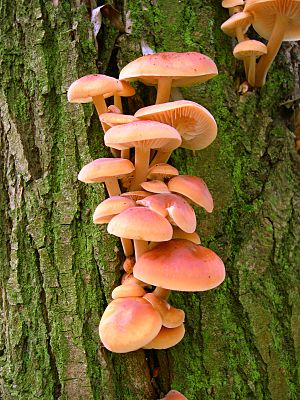Enokitake facts for kids
Quick facts for kids Enokitake |
|
|---|---|
 |
|
| Wild enokitake, Flammulina velutipes | |
 |
|
| Cultivated Flammulina velutipes | |
| Scientific classification | |
| Kingdom: | |
| Division: | |
| Class: | |
| Order: |
Agaricales
|
| Family: |
Physalacriaceae
|
| Genus: |
Flammulina
|
| Species: |
F. velutipes
|
| Binomial name | |
| Flammulina velutipes (Curtis) Singer (1951)
|
|
| Synonyms | |
|
|
Enoki (Flammulina velutipes), also known as velvet shank, is a species of edible mushroom in the family Physalacriaceae. It is well-known for its role in Japanese cuisine, where it is also known as enokitake (榎茸, エノキタケ).
The mushroom naturally grows on the stumps of the Chinese hackberry tree (Celtis sinensis) and on other trees, such as ash, mulberry and persimmon trees. Enoki can be sourced September- March and has been named winter fungus due to its seasonality. Wild forms differ in color, texture, and sliminess and may be called futu, seafood mushrooms, winter mushrooms or winter fungus, velvet foot, velvet stem or velvet shank.
Description
There is a significant difference in appearance between the wild and cultivated types of the mushroom. Cultivated mushrooms have not been exposed to light, resulting in a white color, whereas wild mushrooms usually display a dark brown color. Cultivated mushrooms are grown in a carbon dioxide (CO2)-rich environment to nurture the development of long thin stems, whereas wild mushrooms produce a much shorter and thicker stem.
Flammulina velutipes can be distinguished by its shiny and sticky caps, white spores, and the absence of a ring on the stem. The caps range from 1–5 cm (0.39–1.97 in). The stalks are 2–8 cm (0.79–3.15 in) long and 4–7 mm (0.16–0.28 in) wide.
Commercially farmed enoki is a long, thin white mushroom and is a popular ingredient for soups, especially in East Asian cuisine, but can be used for salads and other dishes. The mushroom has a crisp texture and can be refrigerated for approximately one week. This shape is due to a CO2-rich atmosphere used in farming. The farmed form is also known as golden needle mushroom, futu mushroom or lily mushroom. The farmed F. velutipes is sold both fresh and canned.
Names
| Flammulina velutipes | |
|---|---|
| Mycological characteristics | |
| gills on hymenium | |
| cap is convex | |
| hymenium is adnexed | |
| stipe is bare | |
| spore print is white | |
| ecology is saprotrophic | |
| edibility: choice | |
The names enokitake (、), enokidake (、) and enoki (、) are derived from the Japanese language. In Mandarin Chinese, the mushroom is called 金針菇 (jīnzhēngū, "gold needle mushroom") or 金菇 (jīngū, "gold mushroom"). In India it is called futu, in Korean, it is called paengi beoseot (팽이버섯) which means "mushroom planted near catalpa", and nấm kim châm in Vietnamese. In Hungary it is called ', meaning "winter ear".
Varieties
Two new varieties of F. velutipes are described by scientists on morphological grounds in 2015. They have further proposed in 2018 that F. velutipes var. filiformis, the Asian enokitake, should consitute a separate species F. filiformis on phylogenetic grounds.
The west American variety F. velutipes var. lupinicola has also been proposed to form its own species. As of 2020, both new species are recognized to MycoBank, Index Fungorum, and the NCBI taxonomy tree.
Food and components
Flammulina velutipes is a good edible mushroom, but may have a soft or slimy texture. The wild stipe is too tough to eat. Enokitake mushrooms contain ergothioneine and terpenes.
Similar species
The mushroom could be confused with the poisonous Galerina marginata, which has brown caps and stipe, and brown, rusty spores; it also tends to grow isolated and presents a ring.
Other similar species include Flammulina populicola, Connopus acervatus, Gymnopus villosipes, and Gymnopus erythropus.

